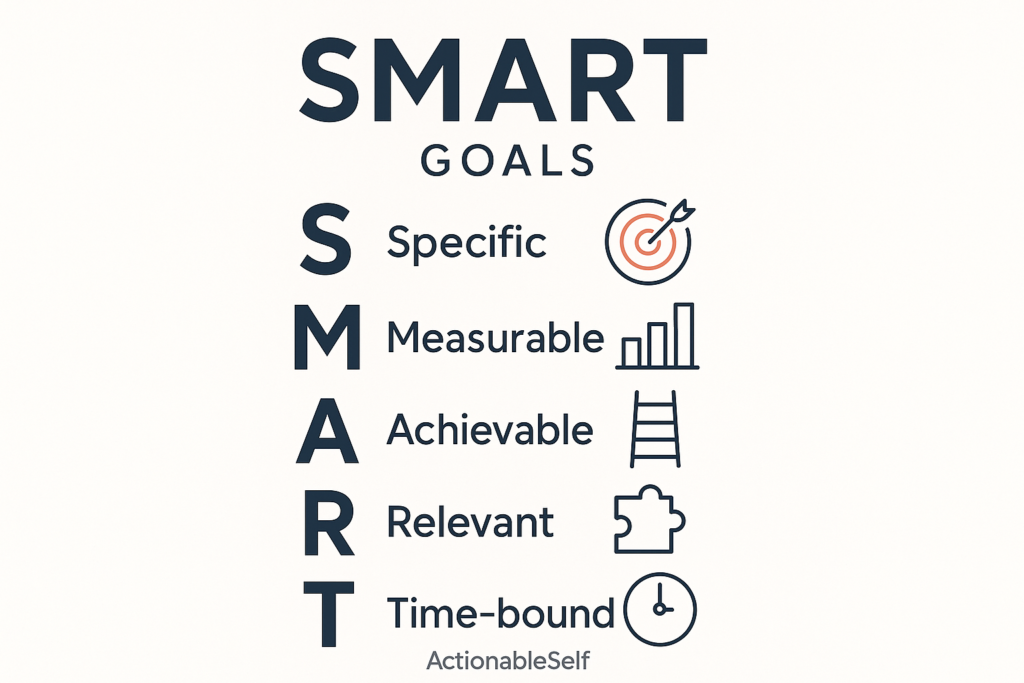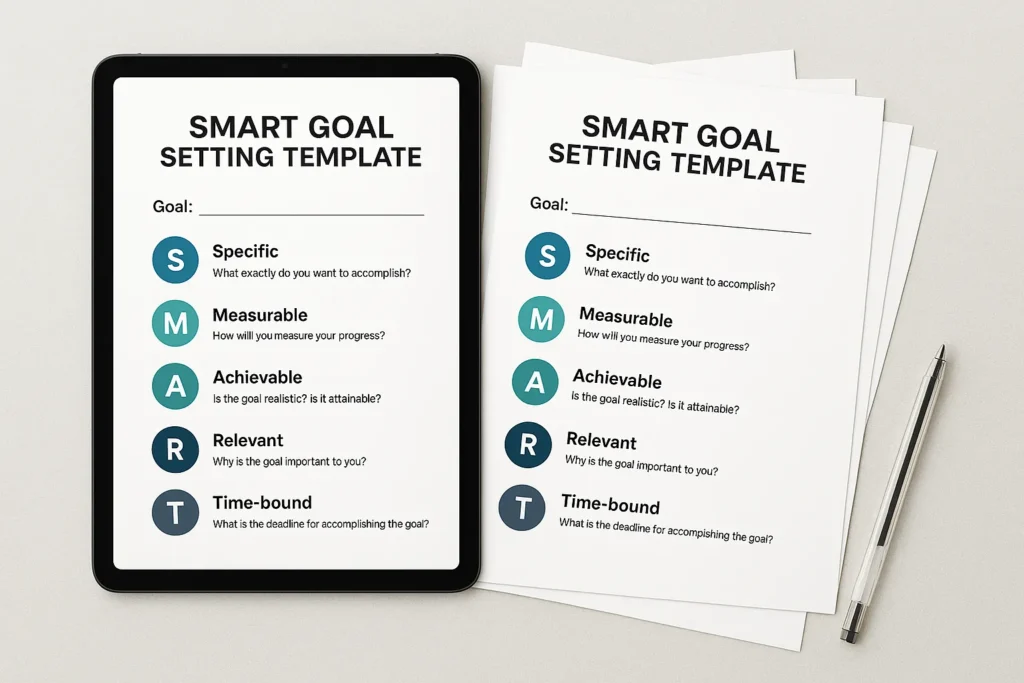You’ve probably heard of SMART goals. The term is everywhere, from corporate boardrooms to personal development blogs. But do you truly understand how to use this framework as the powerful system it was designed to be?
The SMART goals framework is more than just a clever acronym; it’s a proven system for transforming vague, wishful aspirations into clear, actionable targets. It’s the fundamental difference between saying, “I want to be healthier,” and having a concrete, written plan to run a 5k in three months. One is a dream; the other is a smart objective.
This in-depth guide will not only break down each component of this powerful smart framework, but will also provide you with a step-by-step process, real-world examples, and the psychological principles you need to ensure you don’t just set goals—you achieve them.

What Are SMART Goals? A Deeper Definition
The SMART is an acronym that stands for Specific, Measurable, Achievable, Relevant, and Time-bound. It’s a set of criteria designed to help you create goals that are clear, focused, and trackable, dramatically increasing your chances of success. This method is a cornerstone of effective project management and personal development.
Why do vague goals like “get in shape” or “be more successful” almost always fail?
- They Lack Clarity: Your brain doesn’t have a clear target.
- They Offer No Feedback: You can’t track progress, so you lose motivation.
- They Inspire Overwhelm: The goal seems so large that you don’t know where to start, leading to procrastination.
The SMART framework solves these problems by forcing you to apply rigor and clarity to your ambitions. It’s a filter that turns fuzzy desires into a concrete action plan.
The 5 Components of the SMART Goals Framework Explained

Here’s a detailed look at each criterion. For each component, we’ll explore the key questions, common pitfalls, and multiple examples.
Before you apply the SMART framework, you need a general goal to work with. If you’re looking for ideas, our library of over 50 inspiring personal goal examples is a great place to start.
S – Specific (The What, Why, and Who)
A specific goal is clear and unambiguous. It leaves no room for interpretation.
- Checklist of Questions:
- What, exactly, do I want to accomplish?
- Why is this goal important to me?
- Who needs to be involved?
- Where will this take place?
- Detailed Examples:
- Vague: “I want to improve my communication skills.”
- Specific: “I want to become a more confident and articulate public speaker to present my ideas more effectively in team meetings.”
- Vague: “I want to start a side business.”
- Specific: “I want to launch an Etsy shop selling handmade leather wallets.”
- Common Pitfalls:
- Being Too General: “Get better at marketing” is not a goal. “Learn the fundamentals of SEO” is a better start.
- Using Jargon: Be clear and simple.
M – Measurable (The How Much and How Many)
A measurable goal allows you to track your progress and know when you’ve reached the finish line.
- Checklist of Questions:
- How much or how many?
- What is the exact metric for success?
- How will I track my progress?
- Detailed Examples:
- Goal So Far: “I want to become a more confident public speaker…”
- Measurable: “I will join Toastmasters and deliver 3 prepared speeches, aiming for a 50% reduction in filler words.”
- Goal So Far: “I want to launch an Etsy shop…”
- Measurable: “I will launch my Etsy shop with 10 distinct product listings and make my first 5 sales.”
- Common Pitfalls:
- Choosing Vanity Metrics: Tracking “hours spent” isn’t as useful as tracking “tasks completed.”
- Forgetting to Track: A measurable goal is useless if you don’t consistently track it.
A – Achievable (The Realistic Stretch)
A goal must be challenging enough to inspire you, but realistic enough to be achievable.
- Checklist of Questions:
- Is this goal realistic given my current situation?
- What new skills or resources might I need?
- Is this a reasonable stretch, or am I setting myself up for failure?
- Detailed Examples:
- Goal So Far: “I will join Toastmasters and deliver 3 speeches…”
- Achievable: “Delivering 3 speeches in a supportive environment like Toastmasters is a challenging but achievable goal for the next 6 months.”
- Goal So Far: “I will launch my Etsy shop and make 5 sales…”
- Achievable: “Making 5 sales in the first month is an achievable target if I promote it to my social network.”
- Common Pitfalls:
- Overly Ambitious Leaps: Trying to go from zero to hero overnight.
- Ignoring Constraints: Failing to account for your job, family, and other commitments.
R – Relevant (The Why It Matters)
A goal must be important to you and align with your other efforts.
- Checklist of Questions:
- Does this goal truly matter to me?
- Why am I doing this? Does it align with my core values?
- Is this the right time for this goal?
- Detailed Examples:
- Goal So Far: “I will deliver 3 speeches at Toastmasters…”
- Relevant: “Improving my public speaking is highly relevant because my career goal is to move into a leadership position.”
- Goal So Far: “I will launch an Etsy shop…”
- Relevant: “Launching this Etsy shop is relevant because it aligns with my value of creativity and my goal of creating an additional income stream.”
- Common Pitfalls:
- Chasing Someone Else’s Goal: Setting a goal because your friend is doing it.
- Goal Conflict: Setting a goal that directly conflicts with another important area of your life.
T – Time-bound (The When)
A goal needs a deadline. This creates a sense of urgency and prevents procrastination.
- Checklist of Questions:
- What is my target completion date?
- Can I set smaller, intermediate deadlines (milestones)?
- Detailed Examples:
- Final SMART Goal (Public Speaking): “I will become a more confident public speaker by joining Toastmasters this month and delivering three prepared speeches by [Date 6 months from now].”
- Final SMART Goal (Etsy Shop): “I will launch my Etsy shop with 10 product listings by [Date 1 month from now] and achieve my first 5 sales within the first 30 days.”
- Common Pitfalls:
- Open-Ended Timelines: “I’ll do it this year” is too vague. “I will complete it by the end of Q3” is much more powerful.
- Unrealistic Deadlines: Setting a deadline that is too aggressive can create unnecessary stress.
Once you’ve mastered the SMART framework, you might be ready for the next level. Explore advanced goal-setting strategies like OKRs and HARD Goals to tackle your most ambitious objectives.
The Psychology Behind Why SMART Goals Work
Understanding the framework is the first step. Understanding the psychological principles behind it will turn you into a master of achievement.
The Power of Your “Why” (Intrinsic Motivation)
A goal without a strong emotional reason behind it is fragile. Your “why” is the fuel. When you face setbacks, it’s not the “what” that will keep you going—it’s the “why.” Before finalizing any SMART goal, write down 3-5 powerful reasons why achieving it is a must for you.
The Magic of Writing It Down
The simple act of physically writing down your goal has a profound psychological impact. It signals to your brain that this is a serious commitment. Dr. Gail Matthews, a psychology professor, found that you are 42% more likely to achieve your goals simply by writing them down.
Visualize the Outcome and Activate Your Brain
Once your goal is written, take a few minutes each day to visualize yourself having already achieved it. This process activates your brain’s Reticular Activating System (RAS), a network of neurons that acts as a filter. When you clearly define and visualize a goal, you are telling your RAS what is important, and it will begin to subconsciously filter your environment, making you notice opportunities that can help you achieve it.
SMART Goals in Action: A Library of Examples

Here’s how the framework applies to different areas of life with more complete, ready-to-use examples.
SMART Goal Examples for Career
- Learn a New Skill: “I will learn the fundamentals of Python for data analysis by completing the Google Data Analytics Professional Certificate on Coursera, dedicating 6-8 hours per week, with a target completion date of [Date 6 months from now].”
- Expand Network: “I will expand my professional network in the tech industry by attending 3 local tech meetups and having virtual coffee with 5 new contacts I meet there over the next quarter.”
- Improve Performance: “I will increase my sales figures by 15% in Q4 by making 10 additional cold calls per week and completing a sales negotiation course.”
- Get a Promotion: “I will position myself for a promotion to Senior Analyst by taking the lead on one major project, mentoring a junior analyst, and presenting my achievements to my manager in my annual review in [Month].”
- Build a Personal Brand: “I will write and publish 8 articles (2 per month) on my professional blog about digital marketing trends over the next 4 months to establish myself as a thought leader.”
- Improve Work-Life Balance: “I will achieve a better work-life balance by committing to logging off my work computer by 6:00 PM every weekday for the next 30 days.”
- Master a Tool: “I will become the team expert on Asana by completing their online tutorials and creating a new project template for our team to use by the end of this month.”
This SMART goal is a perfect objective to include in a more comprehensive Personal Development Plan (PDP) that you can share with your manager.
SMART Goal Examples for Health & Fitness
- Weight Loss: “I will lose 10kg over the next 5 months (averaging 0.5kg per week) by tracking my calories to stay in a 500-calorie deficit and strength training 3 times per week.”
- Running: “I will train for and run a half-marathon in under 2.5 hours by following a 16-week training plan, with a race date of [Date].”
- Nutrition: “I will improve my gut health by eating 30 different types of plants each week for the next 6 weeks, tracking my intake in a food journal.”
- Flexibility: “I will be able to touch my toes without bending my knees by practicing a 15-minute stretching routine 5 mornings per week for the next 2 months.”
- Mental Health: “I will reduce my anxiety by practicing a 10-minute guided meditation every weekday morning for 60 consecutive days.”
- Sleep Quality: “I will improve my sleep quality to achieve an average ‘Sleep Score’ of 80 on my fitness tracker by avoiding caffeine after 2 PM and creating a screen-free wind-down routine for one hour before bed.”
- Strength: “I will be able to do 10 consecutive, unassisted pull-ups by following a progressive training program, testing my max reps every 4 weeks for the next 6 months.”
SMART Goal Examples for Personal Finance
- Emergency Fund: “I will build a fully-funded emergency fund covering 6 months of living expenses ($18,000) by automatically transferring $750 per month into a high-yield savings account for the next 24 months.”
- Investing: “I will increase my retirement portfolio by investing $500 every month into a low-cost S&P 500 index fund for the entire calendar year.”
- Side Hustle Income: “I will earn an additional $1,000 per month from my freelance writing side hustle within 6 months by sending out 10 targeted pitches per week.”
- Financial Education: “I will read 3 seminal books on investing (‘The Intelligent Investor’, ‘A Random Walk Down Wall Street’, ‘The Little Book of Common Sense Investing’) by the end of this year.”
- Reduce a Major Expense: “I will reduce my monthly food spending by 20% (from $1000 to $800) over the next 3 months by meal planning every Sunday and cooking 5 dinners at home per week.”
- Save for a Goal: “I will save $6,000 for a trip to Japan by opening a dedicated travel fund and setting up an automatic transfer of $250 every two weeks.”
- Credit Score: “I will increase my credit score to over 800 within 12 months by paying off my credit card balances in full each month and disputing any errors on my credit report.”
SMART Goal Examples for Personal Growth & Learning
- Read More Books: “I will read 12 non-fiction books this year (one per month) on topics ranging from history to psychology to science.”
- Learn a New Language: “I will learn the basics of Spanish by practicing on an app like Duolingo for 15 minutes every single day for the next 100 days.”
- Learn a Musical Instrument: “I will learn to play three basic songs on the guitar by following a YouTube tutorial series, practicing for 30 minutes, 3 times a week, over the next 60 days.”
- Develop a Creative Hobby: “I will dedicate one hour every Saturday morning to practicing photography, with the goal of creating a small portfolio of 10 photos I’m proud of.”
- Start a Journaling Practice: “I will write in a journal for 5 minutes every night before bed for one month to improve my self-awareness and process my thoughts.”
SMART Goal Examples for Relationships
- Practice Active Listening: “In my next conversation with my partner, I will focus solely on understanding their perspective without interrupting to share my own.”
- Reconnect with Old Friends: “I will reach out to one old friend I’ve lost touch with each month to schedule a call or a coffee.”
- Strengthen Family Bonds: “I will call my parents every Sunday just to chat and catch up.”
- Set a Healthy Boundary: “I will respectfully say ‘no’ to a social commitment that I don’t have the energy for, instead of saying ‘yes’ out of guilt.”
- Give Genuine Compliments: “I will give one sincere and specific compliment to a colleague or friend each day for a week.”
Free SMART Goal Setting Template
To make this process even easier and more repeatable, we’ve created a fillable PDF template. It walks you through each step of the SMART framework, with prompts and space for you to write, ensuring you create perfectly structured goals every single time. Download it now and turn your ambitions into reality.

Conclusion: From Vague Wishes to Concrete Reality
The SMART goals framework is a simple but profoundly effective tool. It’s a filter for your ambitions, forcing you to bring clarity, focus, and intention to your desires. By using it consistently, you replace wishful thinking with a clear, measurable, and time-bound plan.
Setting SMART goals is a key part of a larger success system. Learn how to integrate them into your life with our Complete Guide to Setting and Achieving Personal Goals.
This clarity is the fuel for consistent action. It’s the blueprint that allows you to build your achievements, one logical step at a time. Stop hoping for a better future and start planning for it.
What is one SMART goal you are setting for yourself after reading this guide? Share it in the comments to make it official!


